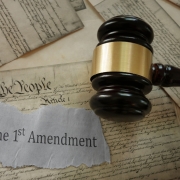Charlotte E. Ray: The Trailblazing First Black Woman Lawyer in the United States
By Brian Figeroux, Esq.
Charlotte E. Ray holds an extraordinary place in American history as the first Black woman admitted to the bar in the United States. Her story is not only one of personal resilience but also a testament to the broader struggles and triumphs of African Americans and women during the 19th century. Her achievements in the legal profession remain a significant milestone in the fight for racial and gender equality.
Early Life and Education
Charlotte E. Ray was born on January 13, 1850, in New York City, to Charles Bennett Ray and Charlotte Augusta Burroughs Ray. Her father was a prominent abolitionist, minister, and editor of the anti-slavery newspaper The Colored American. Growing up in a household deeply rooted in activism and education, Ray was encouraged to pursue intellectual endeavors from an early age.
Ray’s commitment to education led her to attend the Institution for the Education of Colored Youth in Washington, D.C., one of the few educational institutions at the time that welcomed African American students. Later, she enrolled at Howard University, where she pursued teaching and eventually legal studies.
Howard University’s law school was progressive for its time, admitting students regardless of race or gender. Ray graduated in 1872 with a degree from Howard’s Law Department. Her enrollment and graduation were not without challenges, as prevailing societal norms strongly opposed the participation of women, particularly Black women, in higher education and professional fields.
Breaking Barriers: Admission to the Bar
Charlotte E. Ray achieved her historic milestone in 1872 when she was admitted to the District of Columbia Bar, becoming the first Black woman licensed to practice law in the United States. Some sources suggest that she applied under the name “C.E. Ray,” possibly to obscure her gender in a male-dominated field. Whether or not this strategy was deliberate, it underscores the biases she had to navigate to gain entry into the legal profession.
Her admission to the bar was groundbreaking not only because of her race and gender but also because it came during a time when opportunities for Black Americans were severely restricted. The Reconstruction Era (1865–1877) provided a fleeting period of progress for African Americans, but systemic racism and sexism remained deeply entrenched in American society. Ray’s accomplishment served as an inspiration for other African Americans and women to challenge these barriers.
Professional Career and Challenges
Ray began practicing law in Washington, D.C., specializing in commercial law and property law. She opened her own practice, becoming one of the first women in the country to run a law office. Ray’s expertise in property law was particularly significant, as property ownership was a critical issue for African Americans during Reconstruction.
However, Ray’s career faced significant challenges. Her practice struggled to attract clients, a reflection of the pervasive racial and gender prejudices of the era. Many potential clients were unwilling to entrust legal matters to a Black woman, regardless of her qualifications. Moreover, the legal profession itself was unwelcoming to women, who were often excluded from professional networks and opportunities.
Despite her legal acumen, Ray’s practice did not flourish, forcing her to pivot to a career in education. She returned to New York and became a teacher, dedicating herself to nurturing the next generation of thinkers and leaders.
Legacy and Significance
Charlotte E. Ray’s legacy extends far beyond her brief career in law. Her pioneering achievements broke ground for future generations of Black lawyers and women in the legal profession. While she faced insurmountable societal barriers in her own time, her determination and accomplishments set a precedent for others to follow.
Impact on African Americans in Law
Ray’s admission to the bar was a direct challenge to the systemic exclusion of African Americans from the legal profession. Her success demonstrated that Black Americans were capable of excelling in the most demanding intellectual and professional fields, contradicting racist stereotypes prevalent during the era.
Her example also highlighted the importance of access to education and professional opportunities for African Americans. Institutions like Howard University played a crucial role in creating pathways for marginalized communities to break into fields like law, medicine, and academia.
Impact on Women in Law
Ray’s career paved the way for other women to enter the legal profession. At a time when women were largely confined to domestic roles, her admission to the bar represented a bold assertion of women’s rights and capabilities. In 1872, there were few role models for women aspiring to legal careers, making Ray’s success even more significant.
Inspiration for Social Justice Movements
Ray’s life and work align with the broader struggles for civil rights and gender equality in the United States. Her story serves as an early example of intersectionality—the overlapping nature of race, gender, and class discrimination—and the importance of addressing these interconnected issues in the fight for justice.
Recognition and Posthumous Honors
Charlotte E. Ray’s contributions were largely overlooked during her lifetime, a reflection of the societal prejudices that marginalized her achievements. However, her legacy has been increasingly recognized in the years since her death.
- Legal Organizations and Tributes:
- The National Association of Women Lawyers and other organizations have celebrated Ray’s groundbreaking achievements.
- In 2006, the American Bar Association honored her as part of its “Pioneers in the Profession” series, highlighting her role as a trailblazer for women and minorities in law.
- Educational Institutions:
- Howard University, where Ray earned her law degree, continues to honor her legacy by promoting diversity and inclusion in its programs.
- Law schools and historical societies across the country have incorporated her story into their curricula and public programming.
- Cultural and Historical Recognition:
- Ray’s life has been chronicled in books, articles, and documentaries, ensuring that her contributions are remembered and celebrated by new generations.
Conclusion
Charlotte E. Ray’s life and career were marked by extraordinary accomplishments in the face of daunting challenges. As the first Black woman lawyer in the United States, she not only broke barriers in the legal profession but also inspired generations of women and African Americans to pursue careers in law and advocacy. While her legal career was cut short by the systemic biases of her time, her legacy endures as a symbol of courage, determination, and the relentless pursuit of equality.
Ray’s story is a reminder that progress often comes at great personal cost to pioneers who challenge societal norms. Her contributions to the legal profession and to the broader struggle for social justice remain an indelible part of American history.
Citations
- Brown, J. Clay Smith. Emancipation: The Making of the Black Lawyer, 1844–1944. University of Pennsylvania Press, 1993.
- Logan, Rayford W. Howard University: The First Hundred Years, 1867–1967. New York University Press, 1969.
- Harper, Ida Husted. The History of Woman Suffrage, Volume IV. National American Woman Suffrage Association, 1902.
- “Charlotte E. Ray.” American Bar Association Journal, Vol. 92, No. 3, 2006.
- Smith, Jessie Carney. Black Firsts: 500 Years of Trailblazing Achievements and Ground-Breaking Events. Visible Ink Press, 2012.













Leave a Reply
Want to join the discussion?Feel free to contribute!